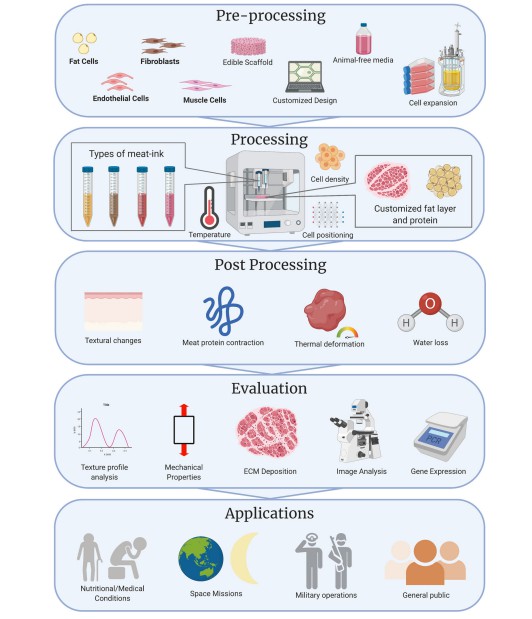3D bioprinting is an innovative process for arranging cellular and non-cellular components, precisely locating and distributing biomaterials with cells to build complex 3D functional living tissues. This technology has a huge market scope in food and nutrition technology, providing a platform for specific end users to build unique food products with enhanced sensory and nutritional value. Many laboratories and companies use 3D bioprinting to create scaffolds that allow cells to grow into muscle fibers for cultured meat production using edible bioinks. Researchers have successfully 3D printed a beef fat structure grown with bovine fat cells and edible biobonds. 3D-printed artificial meat technology offers many benefits to meat consumers, including maintaining the texture, flavor, and nutritional properties of animal meat products by reducing their environmental impact.
 Fig.1. Schematic diagram of major steps considered for 3D printed cultured meat products, their evaluation, and potential applications. (K Handral H et al., 2022)
Fig.1. Schematic diagram of major steps considered for 3D printed cultured meat products, their evaluation, and potential applications. (K Handral H et al., 2022)
There are many meat products on the market with complex structures. To replicate more complex products, our team of experts draws on and refines techniques from tissue engineering, regenerative medicine, and biomaterials science to reconstruct the complex multicellular structure of the meat. As the ideal partner for cultured meat, Lifeasible is committed to developing 3D printing technology for cultured meat. We have advanced modeling software and coating equipment to design the 3D structure of cultured meat, mixing the primary and secondary materials well with the tissue. In addition, our latest 3D printing technology allows local control of the granularity and toughness of the artificial meat to better mimic the 3D structure of real meat.
Our goal is to provide unique 3D printing solutions for essential issues in cultured meat production, especially in regulating protein, fat, and other nutrients and providing realistic textures. Lifeasible develops customized processes for the 3D printing of cultured meat.
(1) Selection of starter cells.
(2) Growth media components.
(3) Bioink development.
Bioink is the raw material for 3D bioprinting, which is made from cells combined with some other biological materials. We develop two types of food-grade bioink materials:
❖Scaffold-based bioink materials: a hydrogel that is printed with cells.
❖Scaffold-free based bioink material: contains only large cellular components, such as tissue chains or spheroids.
(4) Design of software models.
We develop specialized software and printing models to determine the nutritional and sensory characteristics of 3D-printed meat products. Using different combinations of printing parameters, innovative meat inks with realistic texture, mouthfeel, and nutritional content can be generated.
(5) Manufacture of cultured meat in bioreactors.
(6) Feasibility analysis of 3D printed cultured meat.
We analyze the internal and external design of 3D-printed cultured meat, including post-processing parameters such as steaming loss, moisture retention, fat retention, shrinkage, and texture change.
Lifeasible is working on printing technologies that can delaminate fat with muscle cells and connective tissue. Our team has unique expertise in fat and cell-matrix adhesion and can design and analyze the perfect co-culture mixture of lipid and muscle cells to replicate cultured meat. Our 3D printing technology platform always creates great textures. Feel free to contact us for more information.
Reference
Lifeasible has established a one-stop service platform for plants. In addition to obtaining customized solutions for plant genetic engineering, customers can also conduct follow-up analysis and research on plants through our analysis platform. The analytical services we provide include but are not limited to the following:
Why Do Plants Blush When They Are Hungry?
April 26, 2024
STU-CRISPR System Improves Plant Genome Editing Efficiency
April 19, 2024